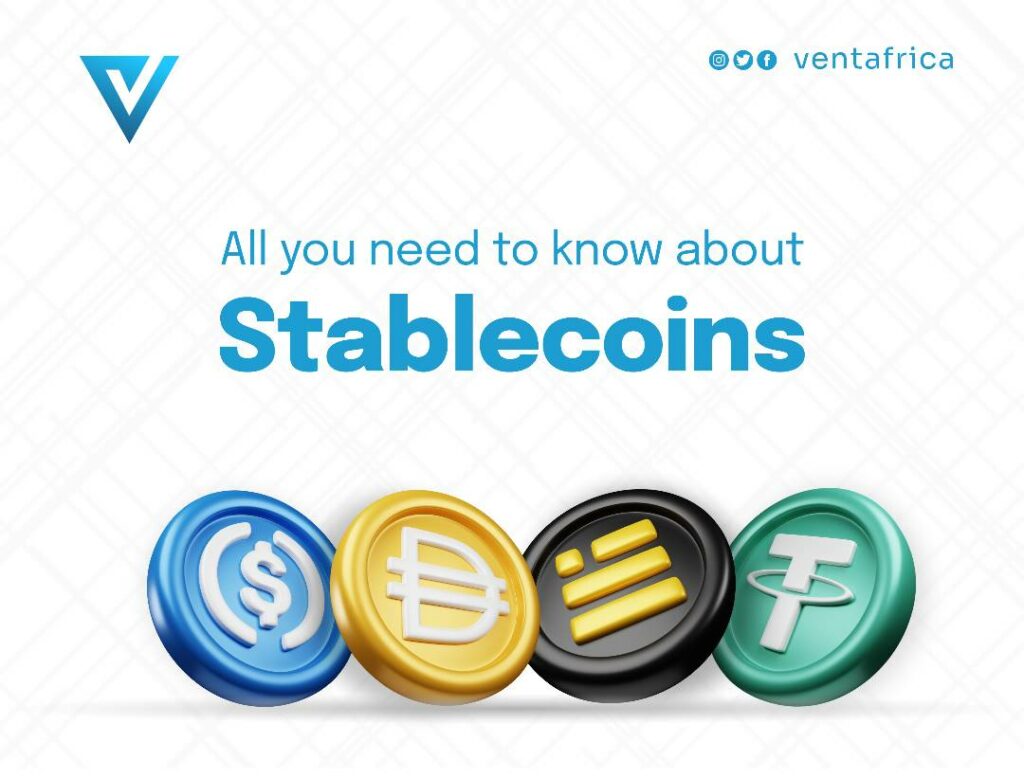All You Need to Know about Stablecoins
Vent Africa now supports USDT, a stablecoin. What are stablecoins?
One of the major features of cryptocurrency is volatility. Stablecoins are the black sheep of the crypto family in that regard. Like the name suggests, they are stable and not prone to volatility like other crypto assets. Have you ever wondered why coins like USDT, TUSD , USDC, etc., never really change in value? Wonder no more. In this post, you’ll learn why.

WHAT ARE STABLECOINS?
Stablecoins are crypto assets tailored to hold a certain value. This is achieved by pegging their value to that of another currency, commodity, or financial instrument (e.g., fiat, gold, etc.)
Generally speaking, cryptocurrencies such as Bitcoin, Ethereum, BNB, Solana, Litecoin, etc., are highly volatile (i.e., prone to frequent fluctuations in price). Although the volatility of cryptocurrencies can be fantastic while trading, these frequent fluctuations in the value of cryptocurrencies become a problem in terms of the usability of these assets as a medium of exchange. In some cases, by the time a cryptocurrency transaction is settled, the transferred coins could already be worth significantly more or less than they were at the time they were sent or at which the transaction was initiated. This could amount to a significant loss for the buyer or seller. Thus, stablecoins exist as a countermeasure against the volatility of traditional cryptocurrencies by maintaining a stable price, making them suitable for use as a medium of exchange.
TYPES OF STABLECOINS
Stablecoins are generally divided into four categories, depending on the method utilised in ensuring their price stability.
- Fiat-backed stablecoins.
- Commodity-backed stablecoins.
- Crypto-backed stablecoins.
- Algorithmic stablecoins.
Fiat-backed Stablecoins
Fiat-backed (or fiat-collateralised) stablecoins have their value pegged to fiat (i.e., government-issued currencies like the dollar, naira, or Euro). This is achieved by keeping a reserve of the fiat currency as collateral for the stablecoin’s value. Such reserves are maintained by independent custodians (traditional financial institutions) who hold an amount of the fiat currency proportionate to the total token supply in reserve.
Examples of fiat-backed stablecoins include USDT (pegged to the U.S. dollar) and EURS (pegged to the Euro).
Commodity-backed stablecoins
Commodity-backed stablecoins are backed by physical commodities like gold, silver, crude oil, or even real estate, making them a digital representation of valuable real-world assets. They allow investors to hold digital assets with the same value as these commodities without needing to get their hands on the actual precious materials.
Examples of commodity-backed stablecoins are Paxos Gold (PAXG), and Tether Gold (XAUt), both pegged 1:1 to the value of one fine troy ounce of a London Good Delivery gold bar.
Crypto-collateralised Stablecoins
Crypto-backed stablecoins are backed by other cryptocurrencies. However, because the cryptocurrency being held in reserve may be prone to high volatility, such stablecoins are usually overcollateralised (the value of cryptocurrency held in reserves exceeds the value of the stablecoins issued).
An example is Wrapped Bitcoin (WBTC), which is backed by Bitcoin and issued on the Ethereum chain.
Algorithmic Stablecoins
Algorithmic stablecoins have their value kept stable through a complex algorithm designed to maintain their value by controlling the availability of the coin.
EXCHANGE YOUR USDT FOR NAIRA ON VENT AFRICA!
Vent Africa continues to be the leading platform for crypto-to-cash transactions. You can convert your USDT to cash on our platform at the best rates and with no fees charged.


One Comment